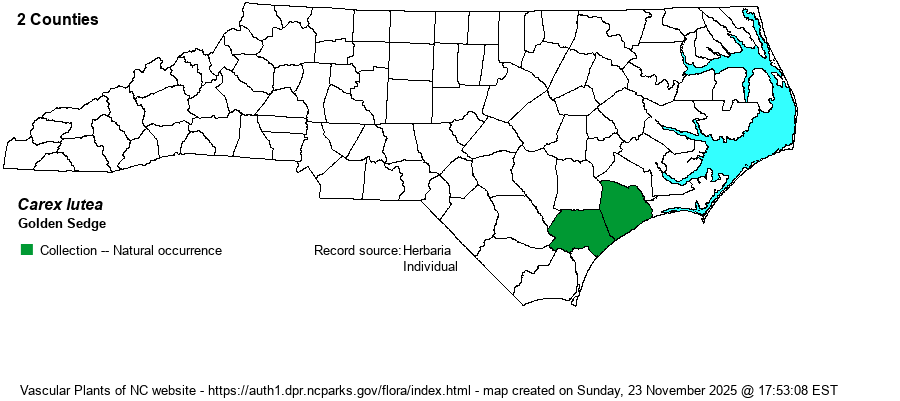| Author | LeBlond | |
| Distribution | Southern outer Coastal Plain only. In NC the species is known from only two counties.
Endemic to Onslow and Pender counties, NC; Charleston County, SC; and Franklin County, FL. The latter 2 were discovered in May and April of 2021, respectively. | |
| Abundance | Rare. Plants are usually locally numerous at a given site. All locations are within a few miles of Maple Hill. The NCNHP database has quite a few records, enough for them to give a State Rank of S2 and thus a Global Rank of G2, and as many of these are on protected and managed conservation lands, the species is not in danger of extinction at the present time. However, it is Federally and State listed as Endangered. | |
| Habitat | Wet pine savannas underlain by coquina marl, with a light canopy of cypress, pines, and Tuliptree (Liriodendron tulipifera). Many other rare species inhabit this special "wet marl savanna" natural community. |
| Phenology | Flowering and fruiting April-August. | |
| Identification | Golden Sedge is a knee-to-waist-high plant with 1-2 (or 3) well-spaced, small female spikes that are distinctly yellow. "golden", or yellow-green in color. This is a rare case of a newly described Carex species that is not a split from another, but literally was a new discovery. | |
| Taxonomic Comments | Discovered in 1991 by Richard LeBlond and described in 1994, this species' nearest relative is Carex flava, a northern species which ranges south only to PA and northern IN.
The genus Carex is the largest in North America, and among the largest in the world. In temperate and boreal regions, Carex is often the dominant or co-dominant ground layer in many habitats. Seeds (achenes) are valuable food for birds and small mammals, while foliage is used by birds and mammals to make nests and as food by mammals. Species of Carex often look vastly different from one another -- spikes erect vs. drooping, tiny inflorescence vs. whopping, culms leafy vs. naked, perigynia beaked vs. beakless, stems densely bunched vs. single, etc. The genus has been divided into many sections (or groups), based on shared characters; some taxonomists have suggested that these be different genera, but that proves unworkable (so far). All Carex share the feature of a perigynium (an outer covering) which completely surrounds the achene (seed). This covering may fit tightly or loosely (like a small bladder), depending on which group or species. Details of perigynia shape, ornamentation, presence and size of beak, number of striations (or veins) are all important ID features. In recent years Rob Naczi and colleagues have stressed the importance of arrangement of perigynia -- whether spiral (3+ ranks) or distichous (2-ranked) -- and have named a number of new species as well as split off some older synonyms. Therefore, RAB's (1968) key, excellent for its time, can only be used in a general way today. Members of some sections of Carex are difficult to key out (notably Ovales, Laxiflorae, Griseae); this is in part due to variation among individuals of a species, or failings of the key. FNA has drawings of most species and some species may be found in two or more places within a key, to acount for variability. New species to NC, and new to science(!), continue to be found in NC. | |
| Other Common Name(s) | Sulphur Sedge | |
| State Rank | S2 | |
| Global Rank | G2 | |
| State Status | E | |
| US Status | LE | |
| USACE-agcp | | |
| USACE-emp | | |

